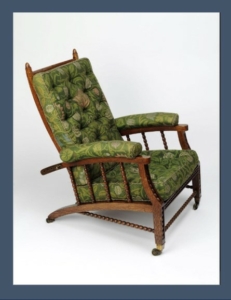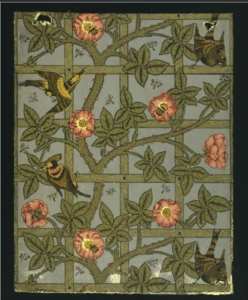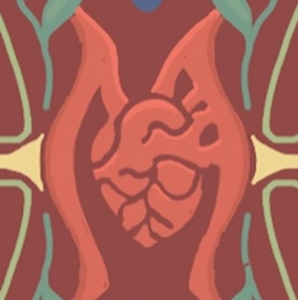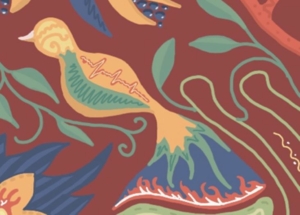How can a holistic perspective benefit practitioners, patients, and the planet?
Felicity Smith, Barts and The London School of Medicine and Dentistry, Year 5
Arts and Crafts in Healthcare: What William Morris can Teach us About the Benefits of a Holistic Perspective for Practitioners, Patients and the Planet
Figure 1. Interwoven – Digital Art Creative Enquiry drawn on iPad inspired by the work of William Morris (2023)
Holistic healthcare recognises the interconnection of different aspects of well-being. We can achieve better outcomes for practitioners, patients and the planet by considering wider social, physical, and emotional needs outside the medical discipline. By using ideas from the artist William Morris, I explore how practitioner, patient and planet benefit from a holistic perspective. This reflection focuses on three themes in Morris’ work, each illustrated by one of his designs. For each theme I consider how the ideas could be applied to medical practice and explain how I represented this in my creative enquiry.
THEME 1 – PURPOSE, FUNCTION, BEAUTY: THE MORRIS ARMCHAIR
Figure 2. The Morris Armchair, designed by William Morris and Philip Webb, made by Morris & Co. c.1883-1900. Oak, turned, with brass castors and fittings; upholstery covers of wool and mohair
William Morris (1834-1896) was a British artist, designer, and social activist associated with the Arts and Crafts movement. He used art and design to improve the lives of the working poor, who had been moved from farm to factory during the industrial revolution. He believed that successful art and design stems from purpose, function, and beauty.
This principle is demonstrated by the Morris armchair (Figure 2). The purpose of the chair was to be simple, study and comfortable. It was inspired by earlier armchairs, but added new function including a reclining back, deep cushioning, and upholstery. The chair is made beautiful with fabrics designed and woven using traditional techniques. Morris believed the design and construction of objects should be considered holistically. Specifically, each design decision should be intentional, the creation process enjoyable, and the relationship of the object to its environment must be understood.
We can draw similarities between the armchair and our consultations. Medical consultations focus on function, working through history, examination, and management. Morris teaches us to also consider the purpose – why has the patient come in and what outcome do they want? We achieve beauty when a consultation is an authentic human experience where both parties are treated with respect and work towards a shared  understanding of the problem and plan. As with the chair, our approach should consider the patient as part of their wider personal environment. Intentional, holistic consultations foster more satisfying relationships (1,2) which lead to better outcomes for patients (3).
understanding of the problem and plan. As with the chair, our approach should consider the patient as part of their wider personal environment. Intentional, holistic consultations foster more satisfying relationships (1,2) which lead to better outcomes for patients (3).
In Interwoven I created a piece in the style of Morris. I enjoyed the process of drawing from the past, modernising his designs and adding medical symbolism. I particularly enjoyed using the technique of quadrant symmetry, inspired by Morris’ symmetrical designs (Figure 4). As I worked on one quadrant, I affected the entire composition as my iPad filled in the surroundings. This evoked the weaving techniques used in the chair, where the pattern would have emerged over time as the weaver worked. It also reminded me of the interwoven relationship between things and how the holistic approach of purpose, function and beauty can be applied to both design and medicine.
THEME 2 – COMMUNICATION AND COLLABORATION: TRELLIS WALLPAPER
Figure 3 – Trellis, wallpaper designed by William Morris and Philip Webb (1862), printed by Jeffrey & Co. Published by Morris & Co (1864)
Throughout his life, Morris brought together artists and designers who shared their work and their political ideals. Collaboration and communication were crucial to him and he employed apprenticeships in a guild system. For the wallpaper, Trellis (Figure 3), Morris designed the trellis pattern, but did not feel confident adding the birds. He therefore asked his friend Phillip Webb to draw the birds on top of the trellis design to achieve the final effect. By asking for help and collaborating with a peer, Morris achieved a result greater than the sum of its parts.
Collaboration is important in holistic healthcare, and only occurs through clear communication between patient and practitioner, as well as among healthcare workers. The trellis wallpaper could not have been achieved without humility and collaboration. How often would we benefit from asking someone to “design the bird” for us? Communication and collaboration are also the first steps to building strong communities, which have been shown to improve population health (4).
I loved this idea of communication and collaboration in Interwoven. I imagined I was working with Morris as his apprentice. I felt inspired by his patterns, especially the intricate networks of his compositions. I drew communicating arteries branching out from the heart of the piece, leading to capillaries that anastomose with the venous system and the kidneys. The arteries are the lifeblood of the piece and they are intertwined and communicating with the natural objects surrounding them.
THEME 3 – NATURE AND ENVIRONMENT: STRAWBERRY THIEF FURNISHING FABRIC
Figure 4. Strawberry Thief – Furnishing fabric designed by William Morris, made by Morris & Co (1883)
Morris loved to draw directly from nature and his garden (Figure 4). He appreciated nature for its beauty and because he believed it had the power to effect change in reaction to the harshness of the factory environment.
How can we bring the natural environment into our consultations? This is often overlooked when it comes to holistic healthcare, and yet the future of our environment is essential to our health (5–7). I think Morris would consider the environment around healthcare in two ways. Firstly, in consultation rooms and hospitals, he would create beautiful settings, to support happier and healthier people. Secondly, he would encourage sustainable practices to maintain a healthy planet. Recent research supports these approaches. Exposure to nature in the hospital environment and improving sustainability have been shown to have positive health outcomes (8,9).
In Interwoven I explored the relationship between health and nature by interweaving birds and flowers with blood vessels, bones and organs. It celebrates our natural world, but also documents what could be lost if we do not protect our environment.
This reflection introduced the works and ideas of William Morris and applied them to modern holistic healthcare. The themes of purpose, function and design, collaboration and communication, and nature and environment can all be used in our day-to-day interactions. I have been inspired by Morris’ ambition to create positive change in the world. I hope my creative enquiry has made you consider holistic medicine from a new perspective and has given you the impetus to consider what change you can make to benefit patients, practitioners and our shared planet.
Figures
Accessed from the V&A museum https://collections.vam.ac.uk/
- Accession no. CIRC.642:1-3-1962
- Accession no. E.452-1919
- Accession no. T.586-1919
References
- Foureur M, Besley K, Burton G, Yu N, Crisp J. Enhancing the resilience of nurses and midwives: Pilot of a mindfulnessbased program for increased health, sense of coherence and decreased depression, anxiety and stress. Contemp Nurse. 2013;45(1):114–25.
- Frey LM, Ratliff JL. The Personal and Professional Experiences of Integrative Nurse Coach Certificate Program Graduates: A Pilot Study. J Holist Nurs [Internet]. 2018 Apr 20 [cited 2023 Jun 29];36(2):134–44. Available from: https://journals.sagepub.com/doi/abs/10.1177/0898010117704516?journalCode=jhna
- Gannotta R, Malik S, Chan AY, Urgun K, Hsu F, Vadera S. Integrative Medicine as a Vital Component of Patient Care. Cureus. 2018;
- Holt-Lunstad J. The Potential Public Health Relevance of Social Isolation and Loneliness: Prevalence, Epidemiology, and Risk Factors. Public Policy Aging Rep [Internet]. 2017 Dec 30 [cited 2023 Jun 29];27(4):127–30. Available from: https://dx.doi.org/10.1093/ppar/prx030
- Paranjothy S, Gallacher J, Amlôt R, Rubin GJ, Page L, Baxter T, et al. Psychosocial impact of the summer 2007 floods in England. BMC Public Health [Internet]. 2011 Mar 3 [cited 2021 Nov 30];11(1):1–8. Available from: https://bmcpublichealth.biomedcentral.com/articles/10.1186/1471-2458-11-145
- Parker ER. The influence of climate change on skin cancer incidence – A review of the evidence. Vol. 7, International Journal of Women’s Dermatology. No longer published by Elsevier; 2021. p. 17–27.
- Breaking the fever: Sustainability and climate change in the NHS | RCP London [Internet]. [cited 2023 Jun 13]. Available from: https://www.rcplondon.ac.uk/projects/outputs/breaking-fever-sustainability-and-climate-change-nhs
- Dijkstra K, Pieterse ME, Pruyn A. Stress-reducing effects of indoor plants in the built healthcare environment: The mediating role of perceived attractiveness. Prev Med (Baltim). 2008 Sep 1;47(3):279–83.
- Moss H, O’Neill D. The art of medicine: Aesthetic deprivation in clinical settings [Internet]. Vol. 383, The Lancet. Elsevier B.V.; 2014 [cited 2023 Jun 29]. p. 1032–3. Available from: http://www.thelancet.com/article/S0140673614605079/fulltext







